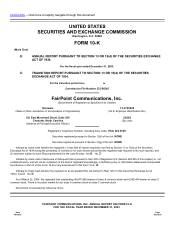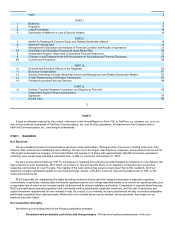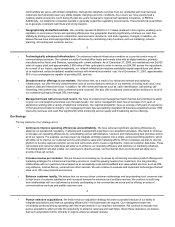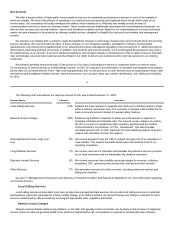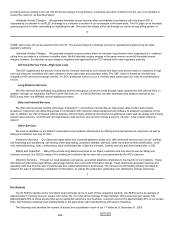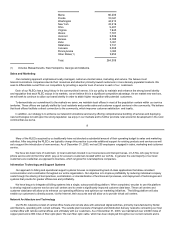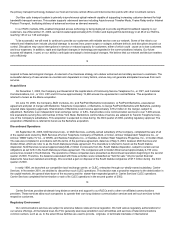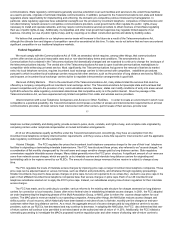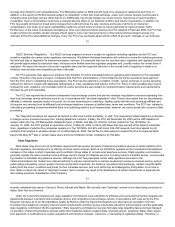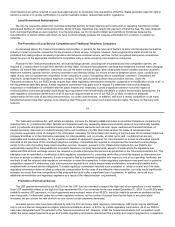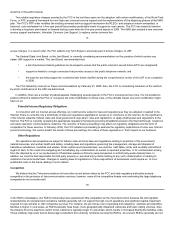FairPoint Communications 2003 Annual Report Download - page 8
Download and view the complete annual report
Please find page 8 of the 2003 FairPoint Communications annual report below. You can navigate through the pages in the report by either clicking on the pages listed below, or by using the keyword search tool below to find specific information within the annual report.
communications. State regulatory commissions generally exercise jurisdiction over such facilities and services to the extent those facilities
are used to provide, originate or terminate intrastate communications. In addition, pursuant to the Telecommunications Act, state and federal
regulators share responsibility for implementing and enforcing the domestic pro-competitive policies introduced by that legislation. In
particular, state regulatory agencies have substantial oversight over the provision by incumbent telephone companies of interconnection and
non-discriminatory network access to competitive communications providers. Local governments often regulate the public rights-of-way
necessary to install and operate networks, and may require communications services providers to obtain licenses or franchises regulating
their use of public rights-of-way. Additionally, municipalities and other local government agencies may regulate limited aspects of our
business, including our use of public rights of way, and by requiring us to obtain construction permits and abide by building codes.
We believe that competition in our telephone service areas will increase in the future as a result of the Telecommunications Act,
although the ultimate form and degree of competition cannot be ascertained at this time. To date, we do not believe that we have encountered
significant competition in our traditional telephone markets.
We must comply with the Communications Act of 1934, as amended, which requires, among other things, that communications
carriers offer services at just and reasonable rates and on non-discriminatory terms and conditions. The amendments to the
Communications Act contained in the Telecommunications Act dramatically changed and are expected to continue to change the landscape of
the telecommunications industry. The central aim of the Telecommunications Act was to open local telecommunications marketplaces to
competition while enhancing universal service. Most significantly, the Telecommunications Act governs the removal of barriers to market
entry into local telephone services, requires incumbent local exchange carriers to interconnect with competitors, establishes procedures
pursuant to which incumbent local exchange carriers may provide other services, such as the provision of long distance services by RBOCs,
and imposes on incumbent local exchange carriers duties to negotiate interconnection arrangements in good faith.
Prior to the enactment of the Telecommunications Act, many states limited the services that could be
offered by a company competing with an incumbent local exchange carrier. The Telecommunications Act preempts state and local laws that
prevent competitive entry into the provision of any communications service. However, states can modify conditions of entry into areas served
by RLECs where the state regulatory commission determines that competitive entry is in the public interest. Since the passage of the
Telecommunications Act, we have experienced only limited competition from cable and wireless service providers.
In order to create an environment in which local
competition is a practical possibility, the Telecommunications Act imposes a number of access and interconnection requirements on all local
communications providers. All local carriers must interconnect with other carriers, permit resale of their services, provide local
11
telephone number portability and dialing parity, provide access to poles, ducts, conduits, and rights-of-way, and complete calls originated by
competing carriers under reciprocal compensation or mutual termination arrangements.
All of our 26 subsidiaries qualify as RLECs under the Telecommunications Act. Accordingly, they have an exemption from the
incumbent local telephone company interconnection requirements until they receive a bona fide request for interconnection and the applicable
state regulatory commission lifts the exemption.
The FCC regulates the prices that incumbent local telephone companies charge for the use of their local telephone
facilities in originating or terminating interstate transmissions. The FCC has structured these prices, also referred to as "access charges," as
a combination of flat monthly charges paid by the end-users and usage sensitive charges paid by long distance carriers. State regulatory
commissions regulate intrastate access charges. Many states generally mirror the FCC price structure. A significant amount of our revenues
come from network access charges, which are paid to us by intrastate carriers and interstate long distance carriers for originating and
terminating calls in the regions served by our RLECs. The amount of access charge revenues that we receive is subject to change at any
time.
The FCC regulates the levels of interstate access charges by imposing price caps on larger incumbent local telephone companies. These
price caps can be adjusted based on various formulae, such as inflation and productivity, and otherwise through regulatory proceedings.
Smaller incumbents may elect to base access charges on price caps, but are not required to do so unless they elected to use price caps in the
past or their affiliated incumbent local telephone companies base their access charges on price caps. Each of our 26 incumbent local
telephone subsidiaries elected not to apply the FCC's price caps. Instead, our subsidiaries employ rate-of-return regulation for their interstate
access charges.
The FCC has made, and is continuing to consider, various reforms to the existing rate structure for charges assessed on long distance
carriers for connection to local networks. States often mirror federal rules in establishing intrastate access charges. In 2001, the FCC adopted
an order implementing the beginning phases of the Multi-Association Group, or MAG, plan to reform the access charge system for rural
carriers. The MAG plan is revenue neutral to our operating companies. Among other things, the MAG plan reduces access charges and
shifts a portion of cost recovery, which historically have been based on minutes-of-use, to flat-rate, monthly per line charges on end-user
customers rather than long distance carriers. As a result, the aggregate amount of access charges paid by long distance carriers to access
providers, such as our RLECs, has decreased and may continue to decrease. In adopting the MAG plan, the FCC also determined that rate-
of-return carriers will continue to be permitted to set rates based on the authorized rate of return of 11.25%. Additionally, the FCC initiated a
rulemaking proceeding to investigate the MAG's proposed incentive regulation plan and other means of allowing rate-of-return carriers to

